
In the closing days of WWII, a Hawker Tempest of 222 Squadron, based at Quackenbruck, Germany, downs a Luftwaffe Focke Wulf 190. The Tempest was more than a match for the German fighter and also scored many shootdowns of the V1 Flying bomb.
Coloured pencil on Bristol Vellum
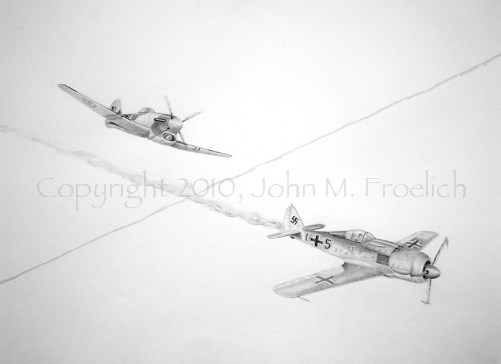
In the last act of WWII, a Hawker Tempest downs a Focke Wulf 190. This picture and the similar "Gotcha!" are preliminary sketches for an oil painting yet to come.
Graphite on Cartridge Paper.
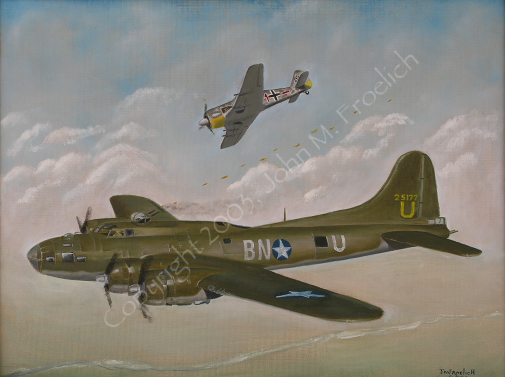
A lone B-17 of the 8th Air Force fends off an attacking Luftwaffe FW-190. The American daylight bombing campaign relied on close formation discipline for mutual fire support. A bomber that became separated from its formation became easy prey for the patrolling German Fighters.
Oil on Canvas board
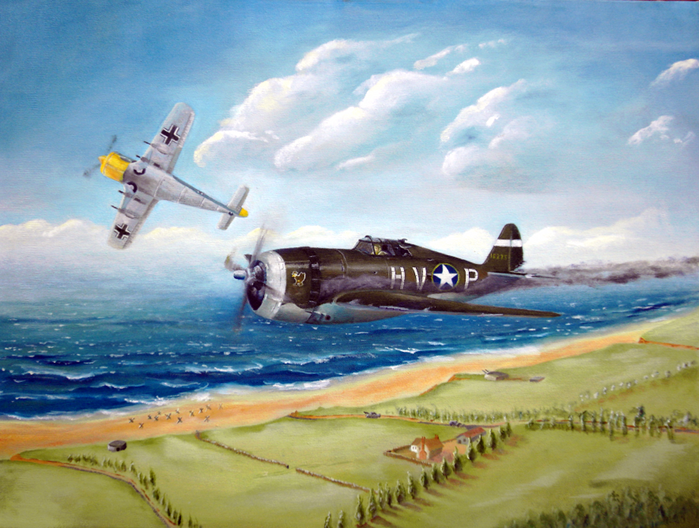
1942; Robert S. Johnson survives a punishing battle with the Luftwaffe despite sustaining more than 200 machine gun and cannon hits on his P-47. He made it safely back to England and went on to become one of the USAAF's highest scoring aces of the war. In this painting, a frustrated FW-190, out of ammunition, peels off over the French coast as an injured Johnson struggles with his heavily damaged fighter. This aircraft was written off and he named the next one "Lucky". No surprise there.
Oil on Canvas. 18in. x 24in (46cm x 61cm)
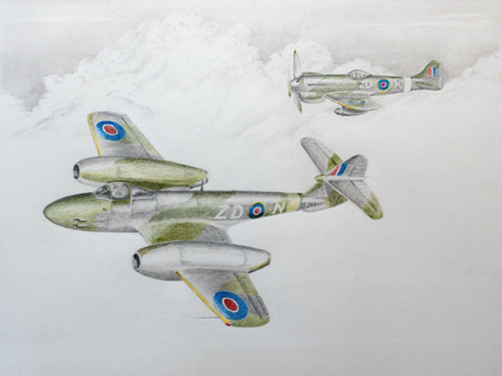
This picture was done for a friend of mine who flew both of these aircraft while serving with 222 Squadron in the closing days of WWII. It represents the transition from the ultimate expression of the piston engined fighter, the Tempest V to the first generation of jets, the Gloster Meteor F3.
Coloured pencil and graphite on paper
Original in private collection

In mid 1945, the RAF's 222 Squadron, which was operating Tempest V aircraft in Germany began training its pilots on the Gloster Meteor F3 at Tangmere airfield near Chichester, West Sussex. This painting commemorates the transition from the ultimate expression of the piston engined fighter to the first generation of jets. A good friend of mine went through this transition and this work is dedicated to him as well.
Oil on Canvas / Panel 45cm x 35cm Original on display in Tangmere Aviation History Museum, Tangmere, UK

On 7 April, 1945, the B-17G "EZ-Goin'", of the 349th Bomb Squadron, Thorpe Abbot, was rammed by a Bf-109 while enroute to its target, Buchen, Germany. Despite losing the left horizontal stabilizer and a good portion of the vertical fin and rudder, the crew continued on to release their bombs on the target. They then managed to fly the heavily damaged Boeing back to Thorpe Abbot and land successfully.
This painting portrays the crew, grateful to be back on the ground in one piece, examining the damage before heading back to quarters for a well earned pint.
Oil on Daler Board

This Painting illustrates the typical activity at a Guild of Aviation Artists sketching day, this one at the DeHavilland museum at St. Albans. The aircraft is a DH Dove, one of my all time favourites, though I've never been fortunate enough to fly one.
Oil on Canvas
Original in Artist's collection (available for sale)
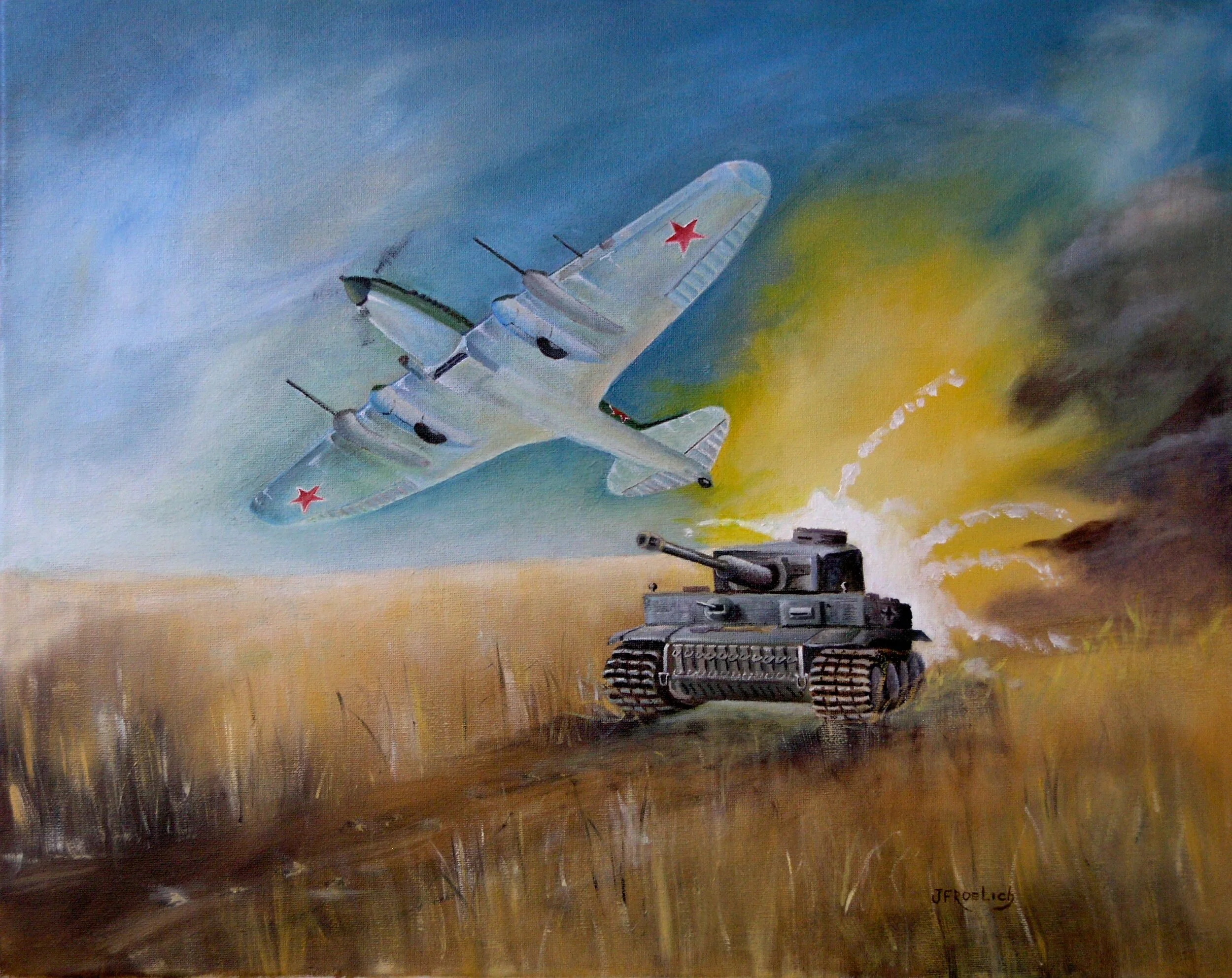
This painting commemorates the 70th anniversary of a major turning point in World War II. In July 1943 the Soviet Army and Air Force blunted Hitler's effort to conquer Russia. This confrontation, the battle of Kursk was a severe blow to the Nazis and a great boost to Russian morale. A key element in this victory was the Ilyushin 2 Sturmovik, a rugged and versatile ground attack aircraft. Heavily armoured and armed, the IL-2 protected the crew and was capable of delivering massive firepower. This scene depicts a Sturmovik pulling out of a low pass on a Tiger Tank of the 'DAS REICH' division.
Oil on canvas
